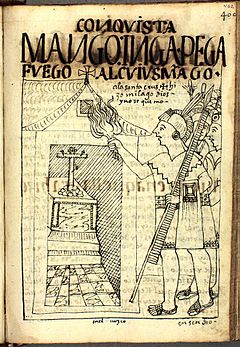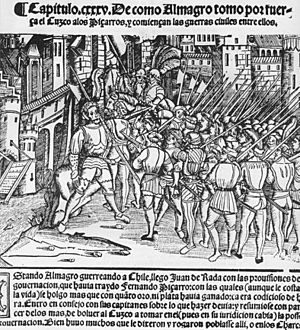Siege of Cusco facts for kids
Quick facts for kids Siege of Cusco |
||||||||
|---|---|---|---|---|---|---|---|---|
| Part of the Spanish conquest of Peru | ||||||||
 The siege of Cusco according to Felipe Guaman Poma de Ayala |
||||||||
|
||||||||
| Belligerents | ||||||||
|
Remnants of the Inca Empire | |||||||
| Commanders and leaders | ||||||||
| Hernando Pizarro (POW) Gonzalo Pizarro (POW) Juan Pizarro II † |
Diego de Almagro Rodrigo Orgóñez |
Manco Inca Yupanqui Cahuide † |
||||||
| Strength | ||||||||
| 30,000 Indios auxiliares 190 Spaniards |
700 Spaniards (as for early 1537), 50,000 Indios auxiliares | 40,000 to 100,000 Inca warriors | ||||||
| Casualties and losses | ||||||||
| Unknown | Unknown, but low | Unknown | ||||||
The Siege of Cusco was a long battle that lasted for 10 months. It began on May 6, 1536, and ended in March 1537. The Inca army, led by their emperor Manco Inca Yupanqui, tried to take back the city of Cusco. Spanish soldiers, called conquistadors, and their native helpers defended the city. They were led by Hernando Pizarro. The Incas hoped to bring back their powerful Inca Empire, but they did not succeed.
Contents
Why the Siege Happened
The Spanish arrived in Peru in the 1530s. Their leader, Francisco Pizarro, was given permission by the King of Spain to explore and conquer the land. In November 1532, Pizarro and his men captured Atahualpa, the Inca emperor, in a city called Cajamarca.
The Spanish later killed Atahualpa, even after receiving a huge amount of gold and silver as ransom. This caused a lot of confusion and fighting among the Inca people. Francisco Pizarro then chose Manco Inca Yupanqui, another Inca prince, to be the new emperor.
However, the Spanish still held the real power. They often treated Manco Inca badly. Two of Francisco's brothers, Juan Pizarro and Gonzalo Pizarro, were especially harsh. They even put Manco Inca in prison in November 1535.
When Hernando Pizarro returned to Cusco, he released Manco Inca in January 1536. Hernando hoped to improve relations with the Inca leader. Manco Inca was still watched by the Spanish, but he had more freedom.
On April 18, 1536, Manco Inca left Cusco. He told Hernando Pizarro he was going to a valley to perform religious ceremonies and find gold. But Manco Inca had a secret plan. He met with his military leaders and warriors to plan a rebellion and attack Cusco.
The Battle for Cusco
Hernando Pizarro soon realized his mistake. He sent his brother Juan Pizarro with 70 horsemen to stop the Incas gathering in the Yucay Valley. Juan's group found some Inca troops and pushed them back.
But then, a messenger told Juan that a huge Inca army was gathering around Cusco. Manco Inca did not attack right away. He waited until his army was fully assembled. It was estimated to be between 40,000 and 200,000 warriors.
Against them were only 190 Spanish soldiers, with 80 of them on horseback. They also had several thousand native allies.
Taking Sacsayhuamán Fortress
The Incas made their first move on May 5, 1536. They captured the Sacsayhuamán fortress, which was located above Cusco. The Spanish had left it empty to focus on defending the city itself.
Sacsayhuamán was a very important place. It gave the Incas a high position above Cusco and a strong base for attacks. The steep hills around the fortress also made it hard for the Spanish cavalry to attack, which was a big advantage for the Incas.
The main siege started on May 6, 1536. Inca warriors came down from Sacsayhuamán into the city. They quickly took control of most of Cusco.
The Inca warriors threw hot stones wrapped in cotton and fiery arrows. These set the thatched roofs of the houses on fire, and the flames quickly spread through Cusco. The Spanish soldiers took shelter in two large buildings near the main plaza. They built barricades inside.
From these buildings, the Spanish fought off Inca attacks. They also made quick raids with cavalry and foot soldiers to try and break the Inca lines. The Incas knew how effective horses were. So, they placed warriors with special slingshots around the city. These slingshots launched ropes with weights (called ayllos) to tangle and stop the Spanish horsemen.
After about a week, the Spanish realized they had to recapture Sacsayhuamán to survive. A native ally of the Spanish, named Pasac, helped them plan an attack.
Fifty horsemen, led by Juan Pizarro, along with native allies, rode out of Cusco. They pretended to retreat towards Lima. This tricked some Inca warriors into leaving the fortress to chase them. Then, Pizarro and his men suddenly turned around and attacked Sacsayhuamán from outside the city.
During this attack, a stone hit Juan Pizarro in the head. He died a few days later from his injury. The next day, the Spanish fought off several Inca counterattacks. They then launched a new attack at night, using ladders to climb the walls.
They captured the lower walls of Sacsayhuamán. The Inca army still held the two tall towers of the fortress. The Inca commanders decided to leave the towers to get reinforcements from Manco Inca's headquarters. This attempt was successful.
The towers were left under the command of an Inca nobleman named Titu Cusi Gualpa. Even though Titu fought bravely, the Spanish and their allies stormed the towers. By the time the Inca commanders returned, Sacsayhuamán was completely under Spanish control.
Fighting Continues
Taking Sacsayhuamán helped the Spanish in Cusco. The fighting then turned into daily small battles. These battles stopped only during the new moon, which was an Inca religious tradition.
During this time, the Spanish used harsh tactics to scare the Inca army. They ordered that any captured women be killed and that captured men have their hands cut off.
Encouraged by their success, Hernando Pizarro led an attack against Manco Inca's main camp. This camp was now at Ollantaytambo, further away from Cusco. Manco Inca defeated the Spanish at the Battle of Ollantaytambo. He used the strong defenses and difficult land around the site to his advantage.
The Spanish soldiers in Cusco had more success with raids to find food in nearby areas. These trips helped them get more supplies, as their food was almost gone. Meanwhile, Manco Inca tried to use his victory at Ollantaytambo to launch another attack on Cusco. However, a Spanish cavalry group accidentally met the Inca army, ruining any chance of a surprise attack. That same night, the Spanish launched a full-scale attack. They completely surprised Manco Inca's troops and caused many casualties.
What Happened Next
After 10 months of intense fighting, Manco Inca decided to end the siege of Cusco. His army's morale was low. He withdrew his forces to Ollantaytambo and then to Vilcabamba. There, he created a smaller Inca state.
Some people believe that by ending the siege, Manco Inca lost his best chance to push the Spanish out of the Inca lands. However, it was likely his only realistic choice. This was because Spanish reinforcements arrived from Chile, led by Diego de Almagro.
Almagro saw that he could gain power in Peru. After helping the Spanish win, he took control of Cusco. He even imprisoned Hernando and Gonzalo Pizarro. Gonzalo later escaped and fought Almagro in a battle called the Battle of Las Salinas.
See also
 In Spanish: Sitio del Cuzco para niños
In Spanish: Sitio del Cuzco para niños


